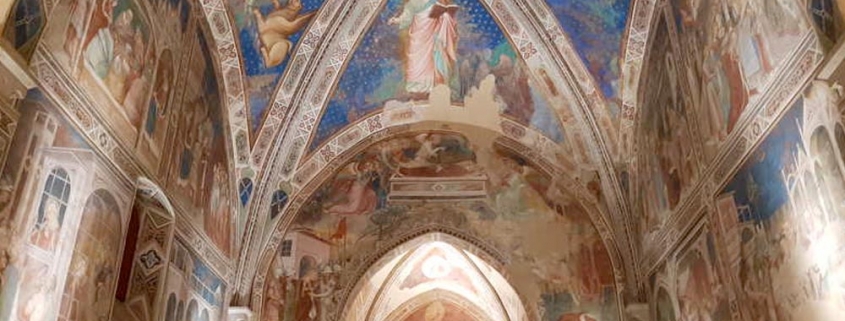The Oratorio of Santa Caterina
Construction on the Santa Caterina Oratory, built on the Rimezzano farm at the foot of the Baroncelli hills, was started in 1354. Jacopo and Giovanni, sons of Alberto Alberti, owner of many properties throughout the Antella Parish, were responsible for its creation.
The building is characterized by its simplicity: the external walls were constructed with limestone blocks while the gabled façade is defined by a portal framed by a lancet arch, containing a once frescoed lunette, and covered by a considerably sloping roof. An ocular window with a stone frame can be found just above. To the back of the chapel stands a small bell tower.
The internal space is rectangular in shape and culminates with an apse separated by a large lancet arch. The space is divided into two bays, both of which are covered by vaults with exposed stone ribbing.
The first bay is devoid of decoration, while the second bay and apse are covered by a beautiful decorative fresco, stretching in some sections over to the vaults. The frescoes recount the life of St. Catherine of Alexandra, venerated in the Middle Ages for her wisdom, patroness of judges and notaries.
The remarkable pictorial cycle begins in the apse with scenes of the martyrdom of the Saint. Two artists, as recently distinguished by experts, worked on this section. They were the so-called Maestro di Barberino, an anonymous painter in the style of Orcagna, and Pietro Nelli (a student of Bernardo Daddi), who was able to mitigate the angularity of the first master by means of an elegant plasticity.
The lunette depicting the Annunciation on the back wall, the depictions of St. Benedict and the Holy Deacon, the decoration of the spandrels and sottarco of the chapel and the three scenes in the apse have been attributed to Barberino. After these works nothing further was added for 30 years, until Benedetto di Nerozzo degli Alberti commissioned paintings depicting the stories of the burial of the Saint in the Oratory in his will. It is thanks to Benedetto’s wish that the unfinished work on the triumphal arch was completed by Spinello Aretino, a well-known late-14th century painter from Arezzo. He finished the decorations on the arch and continued the narration of the life of the Saint through eight episodes, illustrated in the lunettes and lower panels. In the rib vaults he painted the Four Evangelists with their corresponding symbols while on the arch he painted the Apostles with the Agnus Dei. Along the base rest busts of the Prophets.
The ruin of the Alberti family heralded a long period of decline for Oratory.
In 1620 the Rector Francesco Venturi had a door put in near the lower part of the section decorated with a figure of St. Antony Abbot, and he was probably the same person that had the frescoes in the apse whitewashed.
After various changes in ownership, the city of Bagno a Ripoli purchased the Oratory, and in two years of work restored the structure and frescoes, cleaning and consolidating the pictorial cycle, reattaching missing plaster and uncovering paintings covered by previous interventions.
The Oratory is now used for art exhibits, cultural festivals, weddings and events.
This post is also available in: Italian


